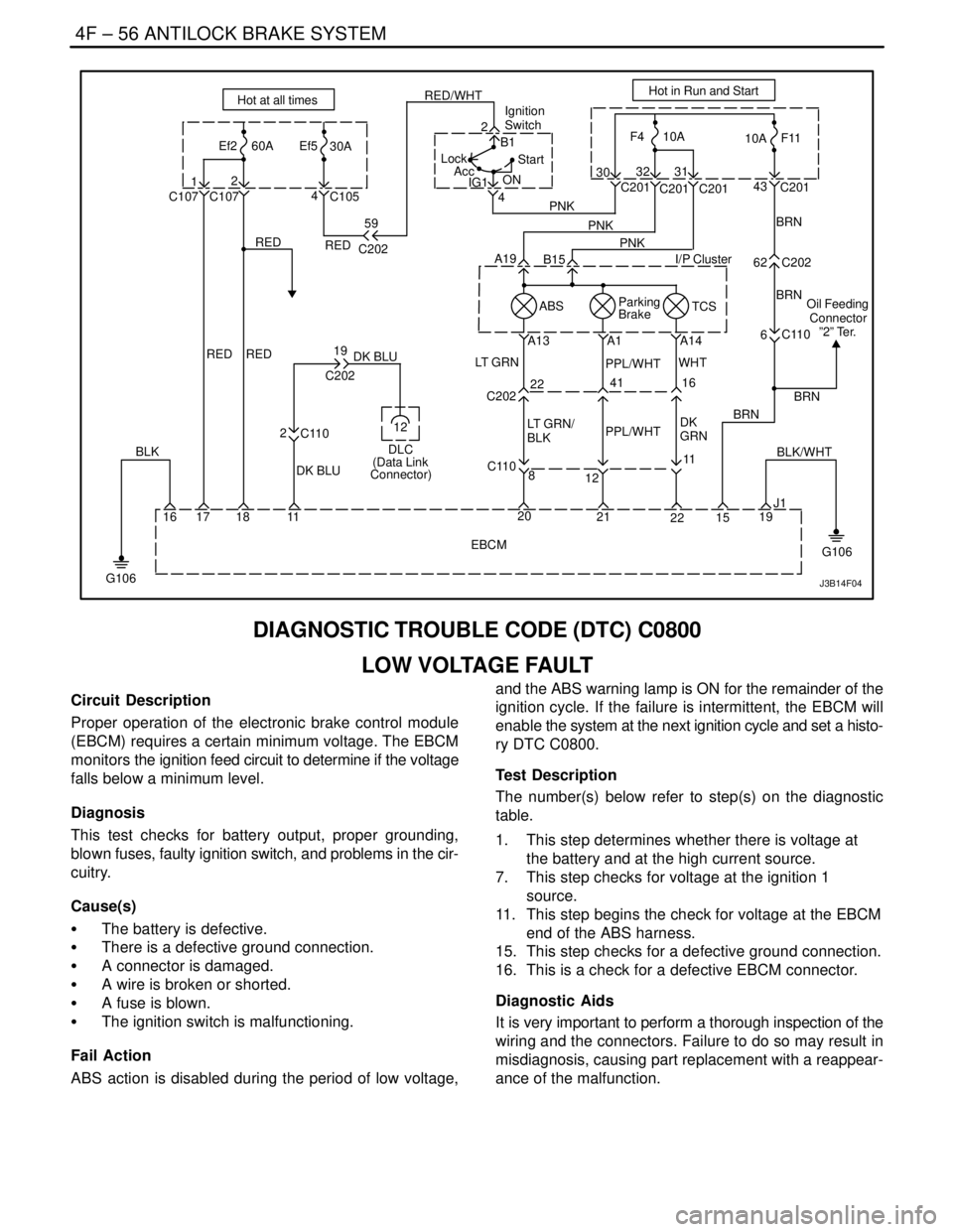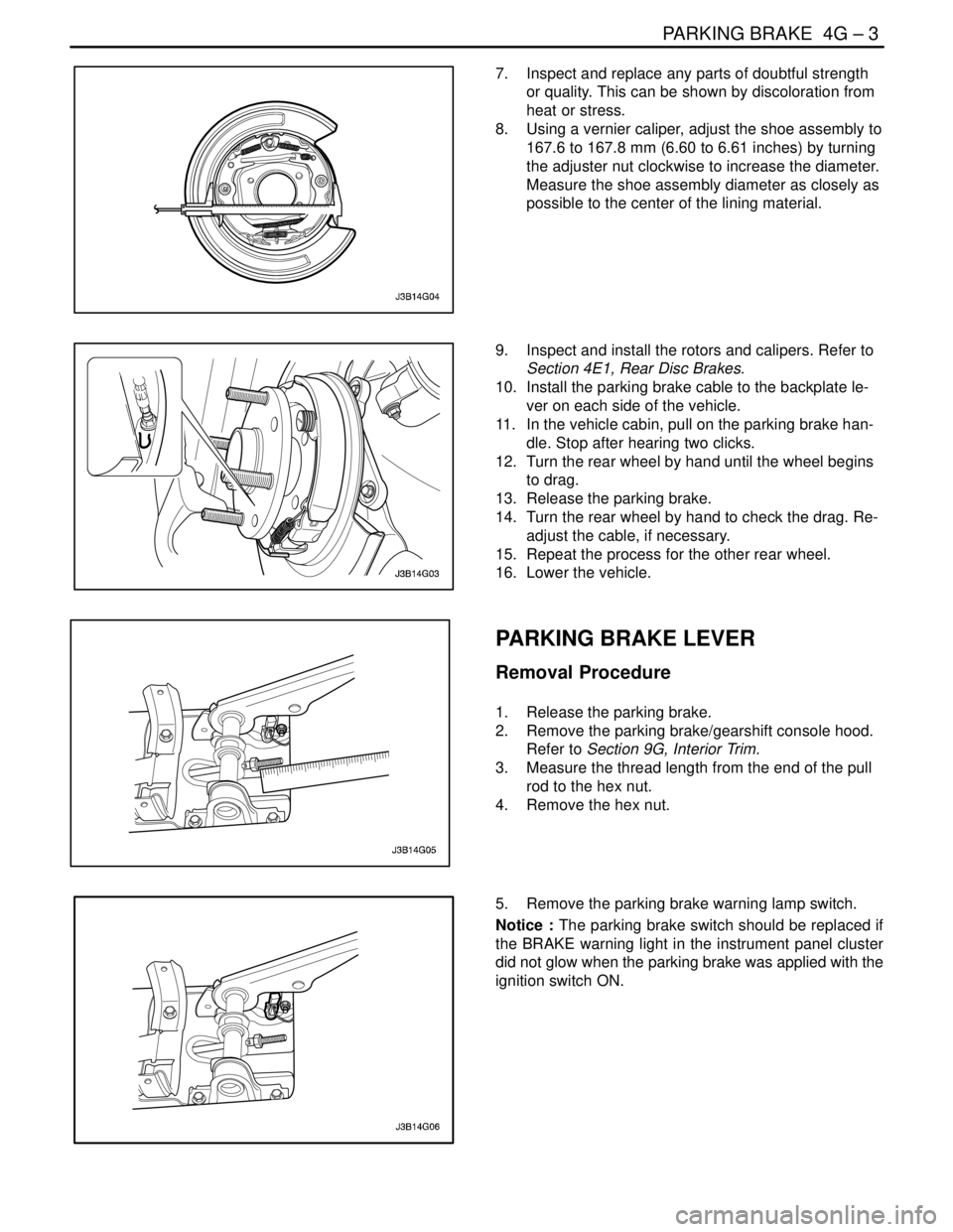2004 DAEWOO LACETTI ignition
[x] Cancel search: ignitionPage 1137 of 2643

4F – 56IANTILOCK BRAKE SYSTEM
DAEWOO V–121 BL4
J3B14F04
60A Ef230A Ef5
2
42
C107 C105
2
C110
G106
A19
A13 A1 A14
C110 C202
C202WHT LT GRN
DK
GRN LT GRN/
BLK
BLK
DK BLUDK BLU
PPL/WHT
PPL/WHT ABS
TCS Parking
Brake
Hot at all times
RED REDRED/WHT
Ignition
Switch
RED
RED
I/P Cluster
EBCM8
20
22 2216 41
1211
18 1621
1
C107
10A F410AF11
32 31
43
6 62 C201
C201 C201C201
C110 C202
Hot in Run and Start
30
4
1711
C202
15
B15
DLC
(Data Link
Connector)12
G106
BLK/WHTOil Feeding
Connector
”2” Ter.
BRNBRN BRN
BRN PNK PNK PNK
19J1
59B1
ONStart Lock
Acc
IG1
19
DIAGNOSTIC TROUBLE CODE (DTC) C0800
LOW VOLTAGE FAULT
Circuit Description
Proper operation of the electronic brake control module
(EBCM) requires a certain minimum voltage. The EBCM
monitors the ignition feed circuit to determine if the voltage
falls below a minimum level.
Diagnosis
This test checks for battery output, proper grounding,
blown fuses, faulty ignition switch, and problems in the cir-
cuitry.
Cause(s)
S The battery is defective.
S There is a defective ground connection.
S A connector is damaged.
S A wire is broken or shorted.
S A fuse is blown.
S The ignition switch is malfunctioning.
Fail Action
ABS action is disabled during the period of low voltage,and the ABS warning lamp is ON for the remainder of the
ignition cycle. If the failure is intermittent, the EBCM will
enable the system at the next ignition cycle and set a histo-
ry DTC C0800.
Test Description
The number(s) below refer to step(s) on the diagnostic
table.
1. This step determines whether there is voltage at
the battery and at the high current source.
7. This step checks for voltage at the ignition 1
source.
11. This step begins the check for voltage at the EBCM
end of the ABS harness.
15. This step checks for a defective ground connection.
16. This is a check for a defective EBCM connector.
Diagnostic Aids
It is very important to perform a thorough inspection of the
wiring and the connectors. Failure to do so may result in
misdiagnosis, causing part replacement with a reappear-
ance of the malfunction.
Page 1138 of 2643

ANTILOCK BRAKE SYSTEM 4F – 57
DAEWOO V–121 BL4
DTC C0800 – Low Voltage Fault
StepActionValue(s)YesNo
1Check the voltage at the battery.
Is the voltage within the specified value?11–14 vGo to Step 3Go to Step 2
2Charge or replace the battery as required.
Is the repair complete?–System OK–
3Check fuse EF2 in the engine fuse block.
Is the fuse blown?–Go to Step 4Go to Step 7
41. Replace fuse EF2.
2. Turn the ignition to ON.
Does the fuse blow again?–Go to Step 5Go to Step 6
51. Turn the ignition to OFF.
2. Trace the RED wires in the ABS wiring harness
from terminal 1 of C107 at the engine fuse
block to terminals 17 and 18 of the EBCM con-
nector.
3. Repair any short circuit found along this path.
Is the repair complete?–System OK–
61. Turn the ignition switch to OFF.
2. Install the scan tool.
3. Clear all DTCs.
4. Road test the vehicle.
Does DTC C0800 reset?–System OK–
7Check fuse F11 in the I/P fuse block.
Is the fuse blown?–Go to Step 8Go to Step 11
81. Replace fuse F11.
2. Turn the ignition to ON.
Does the fuse blow again?–Go to Step 9Go to Step 10
91. Turn the ignition to OFF.
2. Trace the BRN wire from fuse F11 to terminal
43 of connector C201, from terminal 62 of con-
nector C202 to terminal 6 of connector C110,
and from there to terminal 15 of the EBCM
connector.
3. Repair any short circuit found along this path.
Is the repair complete?–System OK–
101. Turn the ignition switch to OFF.
2. Install the scan tool.
3. Clear all DTCs.
4. Road test the vehicle.
Does DTC C0800 reset?–System OK–
111. Disconnect the EBCM connector from the
EBCM.
2. Turn the ignition to ON.
3. Check for the presence of battery voltage be-
tween ground and terminal 17, and between
ground and terminal 18.
Is the voltage within the specified value?11–14 vGo to Step 13Go to Step 12
Page 1139 of 2643

4F – 58IANTILOCK BRAKE SYSTEM
DAEWOO V–121 BL4
StepNo Yes Value(s) Action
121. Turn the ignition switch to OFF.
2. Trace the orange wires between terminals 17
and 18 of the EBCM connector to terminal 1 of
connector C107 at the engine fuse block.
3. Repair the open in this circuit.
Is the repair complete?–System OK–
13Check the voltage between ground and terminal 15
of the EBCM connector.
Is the voltage within the specified value?11–14 vGo to Step 17Go to Step 14
141. Turn the ignition switch to OFF.
2. Check fuse EF5 in the engine fuse block.
Is the fuse blown?–Go to Step 15Go to Step 16
15Replace fuse EF5.
Is the repair complete?–System OK–
161. Examine circuit BRN between terminal 15 of
the EBCM connector to terminal 6 of connector
C110 to terminal 62 of C202, to F11 in the I/P
fuse block.
2. Examine the PNK wire from the I/P fuse block
to terminal 4 (IG1) of the ignition switch.
3. Examine the RED wire from terminal 2 (B1) of
the ignition switch to terminal 59 of connector
C202 to terminal 4 of connector C105 at the
engine fuse block.
4. Repair the open in the wiring or possibly bad
connector terminal, or defective ignition switch.
Is the repair complete?–System OK–
171. Turn the ignition to OFF.
2. Check the resistance between ground and ter-
minals 16 and 19 of the ABS harness EBCM
connector.
Is the resistance equal to the specified value?0 WGo to Step 18Go to Step 20
18Examine terminals 15, 16, 17, 18, and 19 of the
EBCM connector.
Is there a defective terminal?–Go to Step 19Go to Step 21
19Repair the defective terminal or replace the connec-
tor or wiring harness as required.
Is the repair complete?–System OK–
20Repair the defective ground connection.
Is the repair complete?–System OK–
211. Install the scan tool.
2. Clear all DTCs.
3. Road test the vehicle.
Does DTC C0800 set again?–Go to Step 23Go to Step 22
221. Examine the wiring harness and connectors for
causes of intermittent problems.
2. Repair any intermittent problem found.
Is the repair complete?–System OK–
23Replace the ABS unit.
Is the repair complete?–System OK–
Page 1141 of 2643

4F – 60IANTILOCK BRAKE SYSTEM
DAEWOO V–121 BL4
MAINTENANCE AND REPAIR
ON–VEHICLE SERVICE
SERVICE PRECAUTIONS
CAUTION : Brake fluid may irritate eyes and skin. In
case of contact, take the following actions:
S Eye contact – rinse thoroughly with water.
S Skin contact – wash with soap and water.
S Ingestion – consult a physician immediately.
CAUTION : To help avoid personal injury due to poor
braking, DO NOT tap into the vehicle’s brake system
to operate a trailer brake system.
Notice : When fasteners are removed, always reinstall
them at the same location from which they were removed.
If a fastener needs to be replaced, use the correct part
number fastener for that application. If the correct part
number fastener is not available, a fastener of equal size
and strength (or stronger) may be used. Fasteners that
are not reused, and those requiring thread–locking com-
pound will be called out. The correct torque values must
be used when installing fasteners that require them. If the
above procedures are not followed, parts or system dam-
age could result.
Notice : Use only DOT 3 equivalent hydraulic brake fluid.
The use of DOT 5 (silicone) brake fluid is not recom-
mended. Reduced brake performance or durability may
result.
Notice : Avoid spilling brake fluid on any of the vehicle’s
painted surfaces, wiring, cables, or electrical connectors.
Brake fluid will damage paint and electrical connections.
If any fluid is spilled on the vehicle, flush the area with wa-
ter to lessen the damage.
Computer System Service Precautions
Take care to avoid electronic brake control module
(EBCM) circuit overloading. In testing for opens or shorts,
do not ground or apply voltage to any circuit unless
instructed to do so by the diagnostic procedure. Test cir-
cuits only with a high–impedance multimeter. Never re-
move or apply power to any control module with the igni-
tion switch in the ON position. Always turn the ignition to
the OFF position before removing or connecting battery
cables, fuses, or connectors.
General Service Precautions
S Disconnect the EBCM connector before performing
any vehicle welding work using an electric arc weld-
er.
S Do not attempt to disassemble any component des-
ignated as nonserviceable. The hydraulic modulator
and the EBCM can be separated from each other
and replaced separately but cannot be serviced.
They have no replaceable parts, and there is no
access to the components they contain.
Page 1152 of 2643

ANTILOCK BRAKE SYSTEM 4F – 71
DAEWOO V–121 BL4
TIRES AND ABS/EBD
Replacement Tires
Tire size is important for proper performance of the ABS
system. Replacement tires should be the same size, load
range, and construction as the original tires. Replace tires
in axle sets and only with tires of the same tire perfor-
mance criteria (TPC) specification number. Use of any
other size or type may seriously affect the ABS operation.
TIRES AND ABS/EBD
Notice : There is no serviceable or removable EEPROM.
The EBCM must be replaced as an assembly.
The EBCM is attached to the hydraulic unit in the engine
compartment. The controlling element of ABS 5.3 is a mi-
croprocessor–based EBCM. Inputs to the system include
the four wheel speed sensors, the stoplamp switch, the
ignition switch, and the unswitched battery voltage. There
is an output to a bi–directional serial data link, located in
pin K of Data Link Connector (DLC) for service diagnostic
tools and assembly plant testing.
The EBCM monitors the speed of each wheel. If any wheel
begins to approach lockup and the brake switch is closed
(brake pedal depressed), the EBCM controls the sole-
noids to reduce brake pressure to the wheel approaching
lockup. Once the wheel regains traction, brake pressure
is increased until the wheel again begins to approach lock-
up. This cycle repeats until either the vehicle comes to a
stop, the brake pedal is released, or no wheels approach
lockup.
Additionally, the EBCM monitors itself, each input (except
the serial data link), and each output for proper operation.
If it detects any system malfunction, the EBCM will store
a DTC in nonvolatile memory (EEPROM) (DTCs will not
disappear if the battery is disconnected). Refer to ”Self
Diagnostics” in this section for more detailed information.
FRONT WHEEL SPEED SENSOR
The front wheel speed sensors are of a variable reluctance
type. Each sensor is attached to the steering knuckle,
close to a toothed ring. The result, as teeth pass by the
sensor, is an AC voltage with a frequency proportional to
the speed of the wheel. The magnitude of the voltage and
frequency increase with increasing speed. The sensor is
not repairable, nor is the air gap adjustable.
FRONT WHEEL SPEED SENSOR
RINGS
The toothed ring mentioned above is pressed onto the
wheel–side (outer) constant velocity joint. Each ring con-
tains 47 equally spaced teeth. Exercise care during ser-
vice procedures to avoid prying or contacting this ring. Ex-cessive contact may cause damage to one or more teeth.
If the ring is damaged, the wheel–side constant velocity
joint must be replaced.
REAR WHEEL SPEED SENSOR AND
RINGS
The rear wheel speed sensors operate in the same man-
ner as the front wheel speed sensors. They incorporate a
length of flexible harness with the connector attached to
the end of the harness. The rear wheel speed rings are in-
corporated into the hub assemblies and cannot be re-
placed separately, but require replacement of the rear
hub/bearing assembly.
VALUE RELAY AND PUMP MOTOR
RELAY
The valve relay and the motor pump relay are located in-
side the electronic brake control module (EBCM) and are
not replaceable. If one should fail, replace the EBCM.
WIRING HARNESS
The wiring harness is the mechanism by which the elec-
tronic brake control module (EBCM) is electrically con-
nected to power and to ground, to the wheel speed sen-
sors, the fuses, the switches, the indicators, and the serial
communications port. The components, considered part
of the wiring harness, are the wires that provide electrical
interconnection, and connectors (terminals, pins, con-
tacts, or lugs) that provide an electrical/mechanical inter-
face from the wire to a system component.
INDICATORS
The electronic brake control module (EBCM) continuously
monitors itself and the other ABS components. If the
EBCM detects a problem with the system, the amber ABS
indicator will light continuously to alert the driver to the
problem. An illuminated ABS indicator indicates that the
ABS system has detected a problem that affects the op-
eration of ABS. No antilock braking will be available. Nor-
mal, non–antilock brake performance will remain. In order
to regain ABS braking ability, the ABS must be serviced.
The red BRAKE indicator will be illuminated when the sys-
tem detects a low brake fluid level in the master cylinder
or when the parking brake switch is closed (the parking
brake is engaged) or EBD system is diabled.
WARNING : EBD INDICATOR LAMP WIRING IS CON-
NECTED TO THE PARKING BRAKE LAMP. IF THE
PARKING BRAKE LAMP IS TURNED ON WHEN YOU
DRIVING, CHECKING ON WHETHER THE PARKING
BRAKE LEVER IS ENAGED OR THE BRAKE FLUID
LEVEL IS LOW. IF THE SYSTEM HAS NO PROBLEM,
THE EBD SYSTEM IS WORKING IMPROPERLY. THE
EBD SYSTEM MUST BE SERVICED.
Page 1155 of 2643

PARKING BRAKE 4G – 3
DAEWOO V–121 BL4
7. Inspect and replace any parts of doubtful strength
or quality. This can be shown by discoloration from
heat or stress.
8. Using a vernier caliper, adjust the shoe assembly to
167.6 to 167.8 mm (6.60 to 6.61 inches) by turning
the adjuster nut clockwise to increase the diameter.
Measure the shoe assembly diameter as closely as
possible to the center of the lining material.
9. Inspect and install the rotors and calipers. Refer to
Section 4E1, Rear Disc Brakes.
10. Install the parking brake cable to the backplate le-
ver on each side of the vehicle.
11. In the vehicle cabin, pull on the parking brake han-
dle. Stop after hearing two clicks.
12. Turn the rear wheel by hand until the wheel begins
to drag.
13. Release the parking brake.
14. Turn the rear wheel by hand to check the drag. Re-
adjust the cable, if necessary.
15. Repeat the process for the other rear wheel.
16. Lower the vehicle.
PARKING BRAKE LEVER
Removal Procedure
1. Release the parking brake.
2. Remove the parking brake/gearshift console hood.
Refer to Section 9G, Interior Trim.
3. Measure the thread length from the end of the pull
rod to the hex nut.
4. Remove the hex nut.
5. Remove the parking brake warning lamp switch.
Notice : The parking brake switch should be replaced if
the BRAKE warning light in the instrument panel cluster
did not glow when the parking brake was applied with the
ignition switch ON.
Page 1161 of 2643

PARKING BRAKE 4G – 9
DAEWOO V–121 BL4
GENERAL DESCRIPTION
AND SYSTEM OPERATION
PARKING BRAKE
This braking system uses a BRAKE warning light located
in the instrument panel cluster. When the ignition switch
is in the START position, the BRAKE warning light shouldglow and go OFF when the the ignition switch returns to
the RUN position. Whenever the parking brake is applied
and the ignition switch is ON, the BRAKE warning light
should glow.
When the brake is firmly applied, the parking brake should
hold the vehicle with ample pedal travel remaining. Check
for frayed cables, rust, etc. or any condition that many in-
hibit present (or future) free movement of the parking
brake lever assembly.
Page 1162 of 2643

SECTION 5
ELECTRICAL WIRING DIAGRAMS
CONTENTS
1. STARTING & CHARGING SYSTEM5–8 . . . . . . . . . . . . . . . . . . . . . . . . . . . . . . . . . . . . . . . . . . . . . . . . . . . . . . . . . . . . . . . .
1) BATTERY, IGNITION SWITCH, STARTER MOTOR, GENERATOR & PNP SWITCH CIRCUIT 5–8. . . . . . . . . .
2. ECM (ENGINE CONTROL MODULE) : MR–140 5–10. . . . . . . . . . . . . . . . . . . . . . . . . . . . . . . . . . . . . . . . . . . . . . . . . . . .
1) BATTERY POWER SUPPLY, GROUND, EI SYSTEM & CKP SENSOR CIRCUIT 5–10. . . . . . . . . . . . . . . . . . . . .
2) FUEL PUMP, INJECTOR & HEATED O2 SENSOR CIRCUIT 5–12. . . . . . . . . . . . . . . . . . . . . . . . . . . . . . . . . . . . . .
3) IAC, SENSOR(MAP, ECT, TP, KNOCK, ACP & ROUGH ROAD) & LEGR CIRCUIT 5–14. . . . . . . . . . . . . . . . . . .
4) EVAP CANISTER PURGE SOLENOID, CMP SENSOR, CLUSTER & VSS CIRCUIT 5–16. . . . . . . . . . . . . . . . .
5) CLUSTER, FUEL PUMP & TCM CIRCUIT 5–18. . . . . . . . . . . . . . . . . . . . . . . . . . . . . . . . . . . . . . . . . . . . . . . . . . . . . .
6) DLC, MIL LAMP & IMMOBILIZER CONTROL CIRCUIT 5–20. . . . . . . . . . . . . . . . . . . . . . . . . . . . . . . . . . . . . . . . . . .
3. ECM (ENGINE CONTROL MODULE) : HV–240 5–22. . . . . . . . . . . . . . . . . . . . . . . . . . . . . . . . . . . . . . . . . . . . . . . . . . . .
1) BATTERY POWER SUPPLY, GROUND, EI SYSTEM & CKP SENSOR CIRCUIT 5–22. . . . . . . . . . . . . . . . . . . . .
2) FUEL PUMP, INJECTOR & O2 SENSOR CIRCUIT 5–24. . . . . . . . . . . . . . . . . . . . . . . . . . . . . . . . . . . . . . . . . . . . . . .
3) IAC, SENSOR(MAP, ECT, TP, IAT, KNOCK & ACP) & EGR VALVE CIRCUIT 5–26. . . . . . . . . . . . . . . . . . . . . . . .
4) EVAP CANISTER PURGE SOLENOID, CMP SENSOR, CLUSTER & VSS CIRCUIT 5–28. . . . . . . . . . . . . . . . .
5) CLUSTER, FUEL PUMP & TCM CIRCUIT 5–30. . . . . . . . . . . . . . . . . . . . . . . . . . . . . . . . . . . . . . . . . . . . . . . . . . . . . .
6) DLC, MIL LAMP, IMMOBILIZER CONTROL & RON SWITCH CIRCUIT 5–32. . . . . . . . . . . . . . . . . . . . . . . . . . . . .